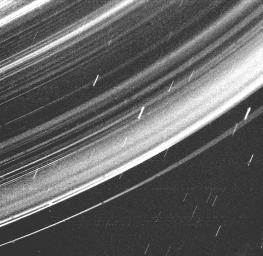
|
Uranus Ring System
- Click the image above for a larger view
- Full-Res JPEG (782 x 763) (168.2 kB)
- Full-Res TIFF (782 x 763) (147.9 kB)
Caption:
This dramatic Voyager 2 picture reveals a continuous distribution of small particles throughout the Uranus ring system Voyager took this image while in the shadow of Uranus, at a distance of 236,000 kilometers (142,000 miles and a resolution of about 33 km (20 ml). This unique geometry -- the highest phase angle at which Voyager imaged the rings -- allows us to see lanes of fine dust particles not visible from other viewing angles. All the previously known rings are visible here, however, some of the brightest features in the image are bright dust lanes not previously seen. The combination of this unique geometry and a long, 96 second exposure allowed this spectacular observation, acquired through the clear filter of Voyager's wide-angle camera. The long exposure produced a noticeable, non-uniform smear as well as streaks due to trailed stars.
Background Info:
The Voyager project is managed for NASA by the Jet Propulsion Laboratory.
Cataloging Keywords:
| Name | Value | Additional Values |
|---|---|---|
| Target | Uranus Rings | Uranus |
| System | Uranus | |
| Target Type | Ring | Planet |
| Mission | Voyager | |
| Instrument Host | Cassini Orbiter | Voyager 2 |
| Host Type | Orbiter | Flyby Spacecraft |
| Instrument | Imaging Science Subsystem (ISS) | |
| Detector | Wide Angle Camera | |
| Extra Keywords | Disk, Dust, Grayscale, Shadow, Visual | |
| Acquisition Date | ||
| Release Date | 1996-01-29 | |
| Date in Caption | ||
| Image Credit | NASA/JPL | |
| Source | photojournal.jpl.nasa.gov/catalog/PIA00142 | |
| Identifier | PIA00142 | |
